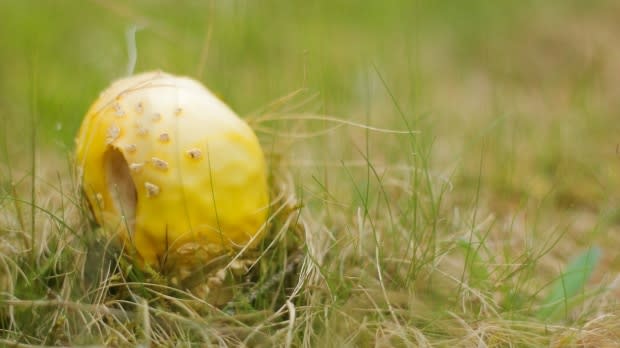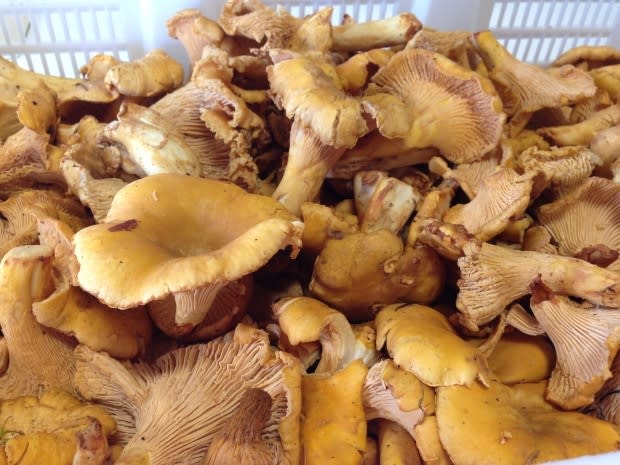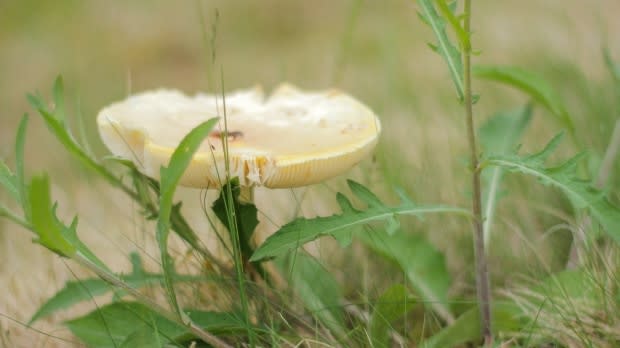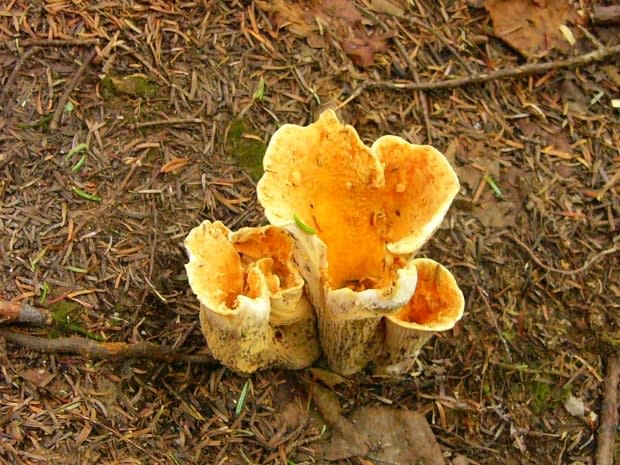Mushroom misconceptions: There's fact, fiction and great flavour to be found

Like the rest of the province, I become obsessed with little golden mushrooms for a few weeks in late summer and early fall.
The electric yellow and orange hues jump out of the forest floor. The hunt is thrilling, because nothing is as delicious as a chanterelle.
I like them on toast. I sauté them and stuff them into tartlets with garlic and parmesan. I fold them into quiches alongside goat cheese and kale from my garden.
While chanterelles are worth their weight in gold, I wanted to spend this summer learning more about Newfoundland's other varieties of fungus. Which are edible? How important are they to the ecosystem of the island? Why does everyone make the same terrible fungi pun ("I'm a fun guy!") when there should be no shortage of terrible mushroom word play?
On a more serious note, rumours surrounding wild mushrooms abound. I've been told you can "safely eat the ones that smell nice" which is definitely not true. I've also noticed dozens of folks asking for identification online, a practice which is dangerous and ill-advised.
There are obviously plenty of misconceptions and misinformation about wild mushrooms, so I reached out to Sarah Jenkins, board member of the mushroom aficionado group Foray Newfoundland and Labrador, and editor of the newsletter Omphalina, to determine the facts about fungi and clear up the fictions.
Fiction #1: Mushrooms are plants
I learned in school that mushrooms firmly belonged in the plant kingdom; they're often what I feed my vegan and vegetarian friends at dinner parties. I find mushrooms in the produce section of the grocery store.
My brain, based on the evidence presented, has long made the connection between mushrooms and plants.
Jenkins informed me I didn't even have my taxonomy correct.
"Early taxonomic systems lumped mushrooms and lichens with plants because they looked somewhat similar, but we now know from genetic analysis that fungi are actually more closely related to animals than plants."
Some further reading showed me animals and fungi seem to share an evolutionary history that branched off from plants 1.1 billion years ago. We (animals and fungi) are linked by an ancient ancestor— most likely a single-celled organism.

It's pretty wild to think that myself and the sourdough culture I neglected during quarantine are linked by some genetic material, but here we are.
Back to the main point: mushrooms are neither animal nor plant, but exist in their own kingdom.
Fiction #2: Mushrooms are vegetables
Mushrooms are not plants and are, therefore, definitely not vegetables.
Mushrooms are actually the fruiting bodies of the fungi.
Essentially, they are to fungi as apples are to its tree. The rest of the mushroom is called "mycelium." This word refers to a network of elongated cells that live underground, inside trees, and in other organisms, but it's not always hidden from view.
Jenkins elaborates, "If you were to flip over a damp log on a rainy day, you might see some bright white filaments between the log and the ground — that's a dense network of mycelium!"
Fiction #3: If humans don't pick them, they'll be wasted
I've heard this one many times in the last few seasons and it's hogwash.
Many species of animals consume mushrooms. In fact, some ecologists have suggested that fungi are the single most important source of food for creatures living in deciduous forests. Bears devour them, as does the lowly slug.
"Besides humans, mushrooms seem to be a food source for rodents and insects. A least, I'm always mad at the squirrels for noshing on my mushrooms before I can identify them," said Jenkins.
Mushrooms, she pointed out, also contribute to local ecosystems by consuming their surroundings.
"Mushrooms can grow out of living trees, out of dead insects, on living animals, or even inside marine invertebrates like sponges. They can form remarkable partnerships with other living organisms. They need many of the same nutrients as us: sugars for energy, as well as nitrogen, phosphorus, and potassium. They essentially eat their homes to gain these nutrients. This means they help to decay and consume old fallen logs, dead leaves, and animal remains," she said.
That might seem spectacularly gross, but a forest where nothing rotted would soon be choked out by the build-up of plant and animal material.

Fiction #4: The chanterelle is Newfoundland's only edible mushroom
Nope. This is a province teeming with delicious edible mushrooms.
The hedgehog mushroom is one of my personal favourites (they make an amazing mushroom broth), but we also play host to a wide variety of boletes.
Until speaking with Sarah, I hadn't realized our celebrated King Bolete is the same mushroom as France's cepe, and Italy's porcini. I had long lingered under the belief these were entirely different mushrooms.
Sarah also pointed me towards the delicious fungi of the west coast.
"If you're lucky enough to call the west coast of the island or Labrador home, keep an eye out for morels in the spring. These represent a complex species that are all equally—and spectacularly—delicious."
Now, on to some facts.
Fact #1: Using Facebook to identify edible mushrooms is a terrible idea
Look, there's a saying I repeat to myself when I forage for mushrooms, "There are old mushroom hunters, and there are bold mushroom hunters, but there are no old, bold mushroom hunters."
More specifically, there are mushrooms in this province that might kill you, so do not eat anything unless you are 100 per cent sure you've identified it correctly.
Sarah described the "Destroying Angel", which is actually a common name for several related mushrooms in Eastern North America. These innocent-looking fungi can be found throughout the forests of Newfoundland, so beware.
She also pointed out that Newfoundland plays host to a variety of little brown mushrooms that can ruin your day, your liver, or worse.

"It is popular now to post a photo of a mushroom to social media groups with the question, "Is this edible?" I would beg people not to do that. Instead, check out some books on mushrooms and find a local group of enthusiasts to go hiking with. Pick mushrooms, learn to observe them up close, smell them, and taste them safely," she said.
Sarah recommends taking mushrooms home and making spore prints for identification. She'd also encourage people to visit the same mushroom site for several days before picking to observe how weather and temperature might impact how mushrooms look or smell.
"Become an expert one mushroom at a time. And please, do not casually ask a group of strangers to determine from a blurry cell phone shot whether your next meal might be your last," she said.
Fact #2: Newfoundland has its own mushroom
While the Newfoundland chanterelle looks identical to the golden chanterelle, it is definitely a distinct species and Jenkins would argue, a superior specimen.
This mushroom was discovered through DNA analysis to distinguish itself from other chanterelles in samples taken all across the province by Andrus Voitk, Greg Thorn, Renée Lebeuf, and Jee In Kim.
On a similar note, one of the researchers, Voitk, recently received a huge honour for his work.
"Just a few months ago, his significant contributions to science were recognized in an honour of the highest kind for a mycophile. He now has a mushroom named after him: Gymnopilus voitkii," said Jenkins.

Fact #3: Mushroom hunting can be a team activity
Foray NL has an annual weekend event during which folks gather to hunt, eat, and discuss all things mushroom. You can also connect with experts fairly easily.
You'll find Shawn Dawson of the Barking Kettle at the St. John's farmer's market. Mark Wilson of the Newfoundland Gourmet Mushroom Company is another great person to connect with. Both are always willing to teach and share information.
There's also a big community of mushroom enthusiasts here, all happy to spread the good word.
Seek them out.
Fact #5: Blabbing about a mushroom patch is a no-no
I touched on this last fall when writing about chanterelle etiquette, but it bares repeating: Mushroom patches are very old and can be slow to produce.
Trampling can damage the mycelium while over-picking can affect next year's harvest and rob other creatures of a food source.
Happy hunting friends! Go slow, learn carefully, and connect with the mushroom community.
Oh, and cool it on the puns.
Read more articles from CBC Newfoundland and Labrador


